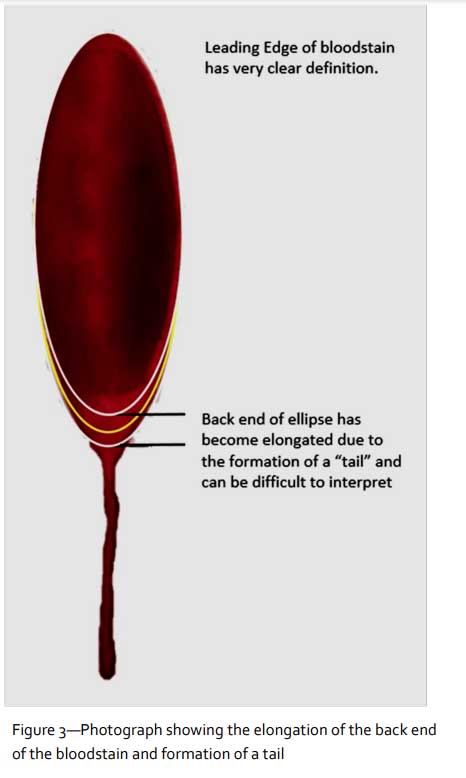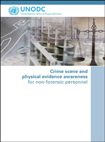|
View in browser: https://www.crime-scene-investigator.net/newsletter/0123.html
|
|
JANUARY 2023 |
|
Accuracy of Digital Ellipse Marking
for Bloodstain Pattern Analysis Eugene Liscio, P.Eng., Craig C. Moore, BSc.
This blind study looked at the accuracy of 101 individuals and how well they could mark a set of 18 digital images of perfect ellipses. 
Bloodstain pattern analysis relies heavily on the understanding and classification of bloodstains found at a crime scene. Analysts examine the size, shape, distribution and location of the bloodstains to try and determine things such as where an assailant may have been located or where a victim was struck. When considering impact stains, both the area of convergence and area of origin may be calculated to demonstrate where the impact took place in two -dimensional or three-dimensional space. Traditional methods of stringing and newer, digital methods often involve identifying and selecting bloodstains to include in an analysis. Part of this process requires that the analyst measures the width and length of each bloodstain and often, this can prove to be a difficult exercise since bloodstains are not always found in perfect form. Depending on factors such as environmental conditions and surface properties of a target surface, bloodstains may be malformed and require some knowledge to interpret the correct shape. Marking errors resulting from incorrectly marked bloodstains (i.e. the marked shape of the ellipse does not agree with the known impact angle or true width to length ratio of the bloodstain) contribute to the overall errors in an area of origin or convergence analysis. Errors may be due to an analyst's subjective interpretation which may be complicated by malformed bloodstains and estimations of where to place an accurate ellipse around an individual bloodstain. One question which has not been addressed in ellipse marking studies is performance when bloodstains are near perfect and photographs are of high quality. Thus, this study addresses a best-case scenario for analysts when most problems associated with bloodstain ellipse marking have been removed. There are two conditions that can exist for any bloodstain. Bloodstains may be circular (i.e. where a blood drop hits a surface at 90° and the length and width are equal), or they may be elliptical, with the length making up the major axis and the width, the minor axis (Figure 1). Passive blood drops such as those dripping from a bloody nose while a person is standing still, appear circular, while blood drops from a person moving (i.e. having any motion component parallel to the impacted surface) will exhibit a more elliptical shape (Figure 2). The impact angle, which is directly related to the shape of the bloodstain, can be expressed by the equation:  where Θ is the impact angle of the bloodstain, w is the width of the bloodstain (minor axis, e.g. 5 mm) and l is the length of the bloodstain (major axis, e.g. 10 mm). < read the complete article. > Related Content
|
|
This Month's Featured Resource on the Crime Scene Investigator Network Website
|

Crime scene and physical evidence awareness for non-forensic personnel United Nations Office on Drugs and Crime The primary target audience of the manual is non-forensic personnel, i.e. first responders and any person involved in the crime scene investigation process without full-fledged training, to help them understand the importance of their actions and the consequences of not applying basic principles of good practice. The manual also targets policy makers, the judiciary and others having to assess, and/or base decisions on evidence presented to them. |
|
New CSI and Forensic Job Announcements
|
|
The most comprehensive listing of Crime Scene Investigation and Forensic To be notified of job openings as they are posted, follow us on Twitter: Job Posting Alerts |
|
Crime Scene Investigator
Greensboro Police Department, Greensboro, North Carolina, USA Final Filing Date: January 20, 2023 Duties include forensic assessment of presenting scene and evidence conditions; victim/witness interviews; recognition, collection and preservation of evidence; forensic photography; sketch/diagram preparation and crime scene mapping; chemical and non-chemical processes for recovery of fingerprints, footwear impressions, biological matter/DNA and other trace/transfer evidence; presumptive testing of suspected blood and unknown substances; extensive note taking and report writing; and the provision of court testimony. <View complete job listing> |
|
Forensic Technician
Glendale Police Department, Glendale, Arizona, USA Final Filing Date: January 22, 2023 The Forensic Technician analyzes, photographs, collects, preserves, and presents evidence from major crime scene investigations and serious traffic accidents. This work is performed in the field, including crime scenes, autopsies, and in the laboratory. <View complete job listing> |
|
Crime Scene Supervisor
Boca Raton Police Department, Boca Raton, Florida, USA Final Filing Date: February 5, 2023 Supervises and evaluates crime scene unit employees; Plans, schedules, evaluates, and counsels crime scene unit staff on work performance to ensure compliance with department policies and procedures; Trains crime scene unit personnel; Processes crime scenes including photographs, evidence collection, diagrams, and other pertinent information; Responds to major scenes to supervise analysis of evidentiary material and laboratory examinations. <View complete job listing> |
|
Forensic Identification Specialist I
Los Angeles County Sheriff, Los Angeles County, California, USA Final Filing Date: The filing period may be suspended at any time without prior notice. Positions in this class learn both field and laboratory analysis including processing crime scenes by recognizing, searching, collecting, and preserving physical evidence; developing latent fingerprints by using conventional techniques; utilizing automated systems for comparing latent fingerprints; and qualifying as an expert witness in court. <View complete job listing> |
 |
|
Forensic Scientist IV - Firearms Identification
Indiana State Police, Fort Wayne, Indiana, USA Final Filing Date: January 20, 2023 To serve as a civilian employee of the Indiana State Police (ISP) whose primary responsibility is to support the Laboratory Division's forensic firearms and tool mark analysis at an entry-level. Upon completion of relevant training, conduct forensic analysis of routine firearms and tool mark evidence utilizing approved Unit Test Methods. <View complete job listing> |
|
Forensic Scientist II Firearms/Toolmarks/Ballistics
Niagara County Sheriff's Office Forensic Laboratory, Lockport, New York, USA Final Filing Date: January 22, 2023 The work involves responsibility for processing items of physical evidence for the purpose of firearms, ammunition, and tool mark identification and analysis using various physical and chemical methods. The incumbent handles complex examinations and cases and exercises a high degree of independence. <View complete job listing> |
|
Latent Fingerprint Examiner
Greensboro Police Department, Greensboro, North Carolina, USA Final Filing Date: January 23, 2023 Primary duties are centered upon the evaluation and comparison of latent friction-ridge impressions, recovered during crime scene/evidence processing, to the known exemplar records of subjects associated with an agency investigation. <View complete job listing> |
|
Evidence & Property Specialist
Ocoee Police Department, Ocoee, Florida, USA Final Filing Date: January 20, 2023 Receives, stores, maintains, and disposes of physical evidence and abandoned property according to applicable Florida law and local ordinances insuring that the chain of custody is not violated. Maintains records of all evidence and property taken into custody and cross-references same. Notifies owner of recovered property. Assists in instructing police recruits on departmental policy and procedures related to handling evidence. Testifies in court in reference to procedures pertaining to all physical evidence or found property collected or received by departmental personnel. <View complete job listing> |
|
Search for more job listings in Crime Scene Investigations and Forensics To be notified of job openings as they are posted, follow us on Twitter: Job Posting Alerts |
|
Other Resources on the Crime Scene Investigator Network Website
|
|
Not Subscribed to this Newsletter?
|
|
If you are not subscribed to this newsletter, you may subscribe with this link: SUBSCRIBE via email |
|
To Unsubscribe
|
|
To unsubscribe from future e-mail alerts, please click here: UNSUBSCRIBE Copyright ©2023 Crime Scene Resources, Inc. Crime Scene Investigator Network |
